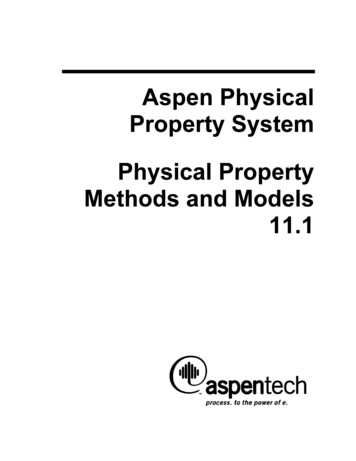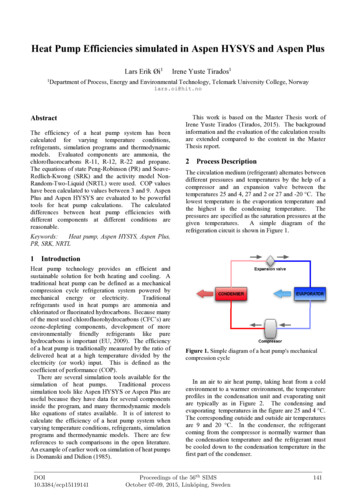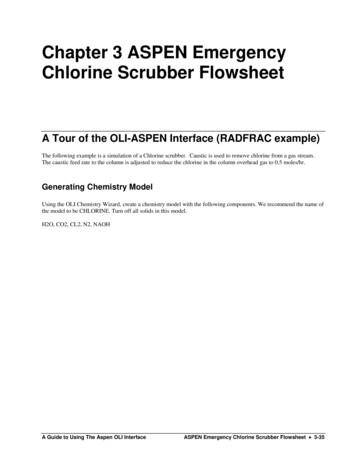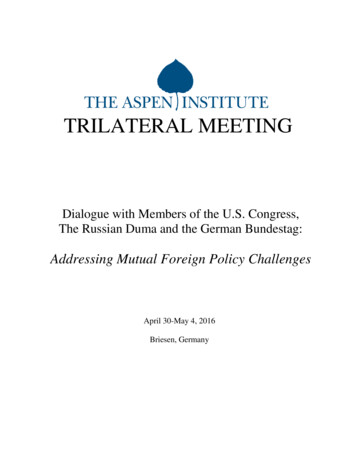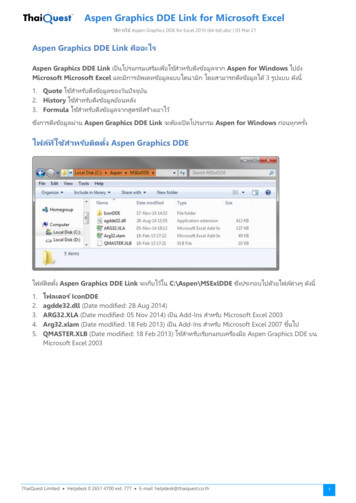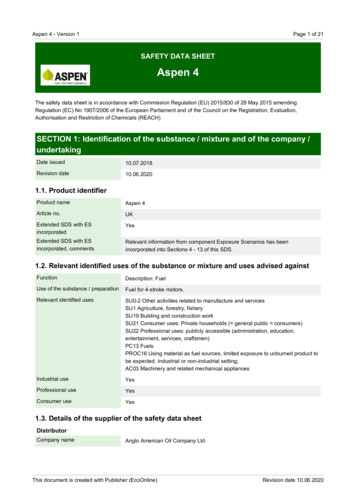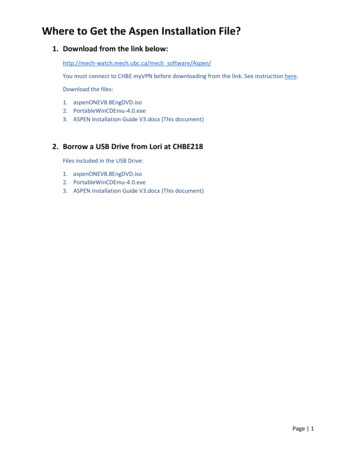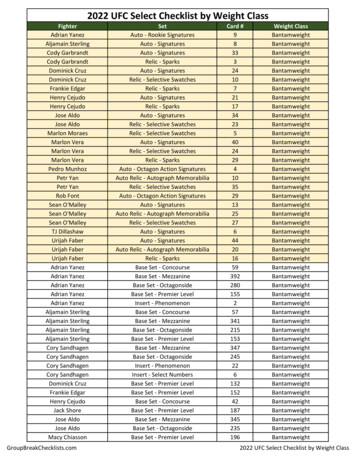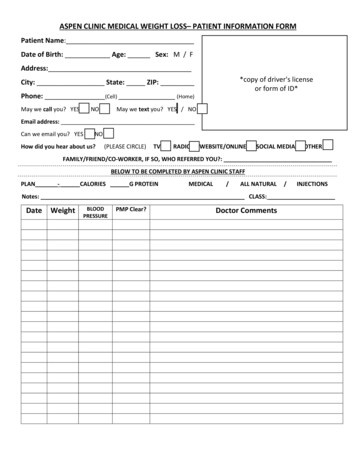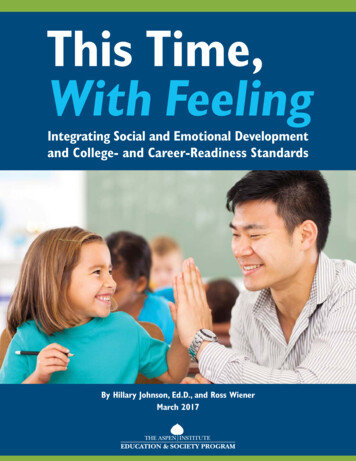
Transcription
This Time,With FeelingIntegrating Social and Emotional Developmentand College- and Career-Readiness StandardsBy Hillary Johnson, Ed.D., and Ross WienerMarch 2017
The Aspen Education & Society Program improves public education by inspiring, informing,and influencing education leaders across policy and practice, with an emphasis on achieving equityfor traditionally underserved students. For more information, visit www.aspeninstitute.org/educationand www.aspendrl.org.The Aspen Institute is an educational and policy studies organization based in Washington, DC.Its mission is to foster leadership based on enduring values and to provide a nonpartisan venue fordealing with critical issues. The Institute is based in Washington, DC; Aspen, Colorado; and on theWye River on Maryland’s Eastern Shore. It also has offices in New York City and an internationalnetwork of partners.Copyright 2017 by The Aspen InstituteThe Aspen Institute One Dupont Circle, N.W., Suite 700 Washington, DC 20036Published in the United States of America in 2017 by The Aspen InstituteAll rights reserved
Contents2Executive Summary4Introduction4What Is Social and Emotional Development (SED)?5Clear Evidence that SED Matters7How the Standards and SED Connect11Developing SED through Academic Instruction13Recommendations to Start Taking Action19Conclusion20Acknowledgments20About the Authors21Endnotes
Executive SummaryThe goal of this primer is to help education leaders understand the mutually reinforcingrelationship between social and emotional development and ambitious academic goals.Instruction that promotes students’ social and emotional development (SED) facilitatesbetter student outcomes on college- and career-ready (CCR) standards. The converse isalso true: Learning environments structured to genuinely meet rigorous standards supportthe development of students’ social and emotional skills. To promote deeper learning,educators need to make the most of this interconnected relationship, and to approach SEDnot as an add-on or discrete intervention, but as an integral part of the academic program.This primer presents an approach to defining SED, which connects the overlapping termsthat educators, developmental psychologists, neuroscientists, and economists use to describethese skills, and provides a summary of the research demonstrating the positive impact ofSED. Now that CCR standards have raised expectations for both students’ independenceand collaboration, the link between academics and SED is even more crucial. To illustratethis, we highlight the required SED skills for a selection of English, mathematics, and sciencestandards, drawn from several different states and organizations to illustrate how CCRexpectations from across the country are dependent on SED. We then present the other sideof the coin: Ambitious academic expectations can create a positive context for developingSED skills. Teaching to CCR standards should be recognized as an opportunity for studentsto learn SED skills, with learning experiences planned accordingly.Moving from awareness to actions that reinforce the relationship between CCR standardsand SED requires a long-term vision and commitment. While the ultimate goal is to fullyintegrate SED into a high-quality academic program and the services that support it, thefirst step will depend on current conditions and context. To provide additional guidance, theprimer closes with a set of a reflective questions and considerations to support system leaders,principals, and teachers who pursue this work.2This Time, With Feeling: Integrating Social and Emotional Development and College- and Career-Readiness Standards
Imagine you are visiting an 11th grade classroom where students are engaged in a performanceassessment as the capstone of an interdisciplinary unit across science, mathematics, and languagearts. Diverse teams of students are engaged in problem solving, collaborating to tackle issues with realimplications for their school experience and the larger community.For their project, the students are advising school leaders on the selection of an additional vendor forthe school’s food services. After being assigned to groups, students must work together to research therelevant issues; develop a strategy; distribute the workload; manage their time and hold each otheraccountable; and integrate the various work streams into a single, coherent proposal that will appeal totheir audience—resolving conflicts and adjusting processes along the way. Over the past few weeks, thestudents reviewed nutritional research and recommendations, identified and reviewed food safety andhealth codes, and familiarized themselves with relevant federal guidelines for the school lunch program.They examined the resources and limitations of the current kitchen facilities. They conducted surveysand focus groups of other students and interviewed cafeteria staff, representatives from other schools,and potential vendors.When you enter the classroom, you find that the teams are in the midst of refining their proposalsand preparing what they hope are compelling presentations. Around the room, students work in smallgroups to create 3-D models, budget spreadsheets, multi-media presentations, and evidence-basedreports. One group debates the likely reactions of the multi-stakeholder, decision-making panel. Anothergroup discusses the relevance and credibility of the nutrition resources they found online. Some studentsare giving feedback to their peers based on the project criteria, including feasibility, cost, health, studentinterest, and ecological impact; other groups are giving each other pointers on presentation style andeffective argument and communication techniques.This is how students prepare for college and careers. Watching these students in action, it is clear thatmeeting these ambitious expectations requires not only subject knowledge and technical skills, but alsosocial and emotional competencies. Students need to manage their own learning, navigate interpersonaldynamics on diverse teams, engage each other in civil and productive debates, get comfortable givingand receiving critiques on their reasoning and presentation style, and accept disappointment whengroup decisions do not go their way. What will it take to ensure that all of our classrooms are positivelydeveloping students’ social and emotional competencies? When we wrestle with what will truly prepareour students for promising futures, it becomes clear that schools must integrate students’ social andemotional development into their mission and their instructional program.This Time, With Feeling: Integrating Social and Emotional Development and College- and Career-Readiness Standards3
IntroductionThe goal of this primer is to help education leaders understand the mutually reinforcingrelationship between social and emotional development (SED) and ambitious academic goals.We argue that instruction that promotes students’ SED facilitates better student outcomes oncollege- and career-ready (CCR) standards. The converse is also true: Learning opportunitiesstructured to genuinely meet rigorous standards support the development of students’ socialand emotional skills. To promote deeper learning, educators need to make the most of thisinterconnected relationship, and to approach SED not as an add-on or discrete intervention,but as an integral part of the academic program.To promote deeper learning,educators need to approach SEDnot as an add-on or discreteintervention, but as an integralpart of the academic program.This primer provides an overview of the issues and a summary of key points,guided by the following questions: W hat is SED and what does research say about why it matters for studentsuccess? How are SED and CCR standards inextricably linked? W hat are the implications for educational leaders as they prepare tointegrate CCR standards and SED in practice?What Is Social and EmotionalDevelopment (SED)?The Aspen Institute’s National Commission on Social, Emotional, and Academic Developmentuses the term “social, emotional, and academic development” (SEAD) to refer to the fullintegration of these domains of student learning. This primer argues that CCR standardsdemand this integration of social, emotional, and academic development into a holisticapproach for improving student learning.To make this argument, we have chosen to use “social and emotional development” (SED)as a broad term for the many ways that educators and researchers define the work to supportstudents to develop as individuals and in relationship to others. We use “development” ratherthan “learning” to encompass the broader context and sets of experiences through whichstudents grow, and to not limit the definition to direct instruction on social and emotionalskills. Educators, developmental psychologists, neuroscientists, and economists describetheir work with different terms and at various levels of detail and scope, but the underlyingconcepts are often similar or overlapping.14This Time, With Feeling: Integrating Social and Emotional Development and College- and Career-Readiness Standards
SED scholar Stephanie Jones and her team at Harvard University are developing a methodto analyze and connect these underlying concepts.2 Through this work, they have found thatthe skills described tend to fall into five domains: emotional, social, cognitive, character,3 andmindset.4 The table below shows the attributes within each of the domains:EmotionalSocial Self-awareness: emotional knowledge and expression Self-management: emotional and behavioral regulation Navigating social situations Social awareness: understanding social cues EmpathyCognitive Attention control Cognitive flexibility Planning, organizing, and setting goalsCharacter MindsetGritCuriosityOptimismEthics Growth mindset Purpose BelongingClear Evidence that SED MattersThe field is experiencing a unique moment: Recent research in brain science and educationlink academic learning inextricably to students’ emotions and mindsets, findings that arepenetrating popular media and energizing policymakers, educators, and social entrepreneursas never before.5 Advances in neuroscience demonstrate that, contrary to previously heldbeliefs, emotion and learning are interdependent. As University of Southern Californianeuroscientist Mary Helen Immordino-Yang notes, “It is neurobiologically impossible tobuild memories, engage complex thoughts, or make meaningful decisions without emotion.”6This unique moment also is shaped by widespread adoption and early implementation ofCCR standards. Whether states designed their own standards or used cross-state efforts suchas the Next Generation Science Standards or the Common Core State Standards initiative,these efforts share an important goal: to establish a vision for student learning that prioritizesproblem-solving and critical thinking in addition to ensuring basic skills. Given the level ofstudent effort and engagement these standards require, they can only be met by studentswho have developed healthy social and emotional skills. Promoting these skills furtherrequires teachers and school leaders to create culturally responsive and affirming schoolsand classrooms. Likewise, it has become more commonly understood that success in collegeThis Time, With Feeling: Integrating Social and Emotional Development and College- and Career-Readiness Standards5
and in the workplace requires not just academic knowledge and ability but also SED skillssuch as persistence, interpersonal skills, and self-control.7 CCR standards and SED are notalternatives; both are integral to student success in school and beyond.Compelling research demonstrates that developing students’ social and emotionalskills improves a wide range of outcomes—starting with their performanceCompelling researchin the classroom. A 2011 meta-analysis of 213 school-based, universal SEDdemonstrates that developing programs involving 270,034 students in kindergarten through high schoolstudents’ social and emotional found an 11 percentile-point gain in academic achievement (as well as positiveskills improves a wide range of effects on mental health and behavioral outcomes) for students in treatmentgroups compared to those in control groups.8 A 2012 analysis by the Nationaloutcomes—starting with theirResearch Council found that developing SED skills is associated with increasedperformance in the classroom.engagement in learning and reduced behaviors that interfere with learning.9Research on college dropouts reviewed by Rutgers Professor Maurice Elias findsthat students’ failure to graduate is “less the result of intellectual shortcomingsand more due to deficiencies in the social-emotional and character competencies necessaryfor dealing productively with the challenging life situations of college.”10The benefits of SED continue long after school ends. University of Chicago economist JamesHeckman established a decade ago that social and emotional skills increase productivity,wages, and avoidance of risky behavior.11 Since the Heckman study, the evidence hascontinued to build. A 2015 cost-benefit study found that every dollar invested across six SEDinterventions yields an 11 return in earnings, health, reduced crime, and other long-termbenefits.12 Moreover, trends over the past two decades reveal that jobs requiring high socialskills have been growing significantly as a share of the labor market, and wage growth in thosejobs has been “particularly strong,” while those with low SED requirements are stagnating ordisappearing, according to Harvard education and economics professor David J. Deming.13Most teachers are convinced of the connection between SED and positive outcomes.According to a 2013 survey commissioned by the Collaborative for Academic, Social, andEmotional Learning (CASEL), 87 percent of teachers believe a larger focus on SED wouldimprove workforce readiness, and 78 percent believe it would improve college preparation.14Yet only 44 percent of teachers surveyed reported that SED is taught schoolwide. The gapbetween what teachers believe will benefit students and what they see taught presents a greatopportunity to leverage teachers’ confidence in SED, but closing this gap must be donepurposefully. Integration of SED into CCR standards-aligned instruction as one holisticpackage—rather than treating it as an add-on, siloed initiative with separate offices andstand-alone interventions—can streamline and strengthen the work of teachers, principals,and district leaders.The link between SED and achieving CCR standards is also a matter of equity. To genuinelyengage and persevere in intellectual risk-taking, students need strong SED competencies.K. Brooke Stafford-Brizard, an adviser for Turnaround for Children, an organization thatapplies findings from neuroscience to develop tools for academic improvement in high poverty schools, argues that “many children, particularly those who grow up in adversity, need6This Time, With Feeling: Integrating Social and Emotional Development and College- and Career-Readiness Standards
Teachers Believe Greater Emphasis on Social and Emotional Learning Would HaveMajor Career, School, and Life BenefitsLarger focus on social and emotional learning would have a major benefit on this:Preparing students for the workforce87%Students’ becoming good citizens as adults87%Students’ ability to move successfullythrough school, stay on track to graduatePreparing students to get toand through collegeStudent achievement inacademic coursework80%78%75%Source: John Bridgeland, Mary Bruce, and Arya Hariharan, The Missing Piece: A National Teacher Survey on How Social and EmotionalLearning Can Empower Children and Transform Schools, Civic Enterprises with Peter D. Hart Research Associates, 2013, p. 29, he-missing-piece.pdf.additional supports for nonacademic development.” Stafford-Brizard writes that“these young people are often labeled with learning disabilities or behavioraldisorders when, in fact, they may be missing foundational skills for learning”that can be acquired through deliberate instructional strategies.15 Educator andauthor Zaretta Hammond notes that inattention to students’ social and emotionaldevelopment compounds challenges when students struggle academically, suchthat “over time, many students of color are pushed out of school because theycannot keep up academically because of poor reading skills and a lack of socialemotional support to deal with their increasing frustration.”16 Integrating afocus on SED into instruction helps ensure all students can access and wrestlewith rigorous academic content.The link between SED andachieving CCR standards is amatter of equity. To genuinelyengage and persevere inintellectual risk-taking, studentsneed strong SED competencies.How the Standards and SEDConnectNow that academic standards have been raised substantially and the expectations for bothindependence and collaboration increased, the link between SED and academic standardsis even more crucial. Many CCR standards refer explicitly to SED, while for other standardsthe relationship is unstated but essential due to the level of effort and capacity that thestandards require.17This Time, With Feeling: Integrating Social and Emotional Development and College- and Career-Readiness Standards7
Below, we highlight the required SED skills for a selection of English, mathematics, and sciencestandards. We have drawn these examples from several different states and organizations toillustrate how CCR expectations from across the country are dependent on SED. Note thatthe sample standards referenced may draw on multiple SED skills in one or more of the fivedomains: Emotional, Social, Cognitive, Character, and Mindset. For brevity and clarity, wehave chosen to highlight some but not all of the relevant skills.English Language ArtsAlthough the specifics of states’ English language arts standards vary, most address a rangeof language skills across reading, writing, speaking, and listening—explicitly requiringinstruction on a broad range of communication competencies rather than a narrow focussolely on reading. According to the introduction to the Massachusetts Curriculum Framework forEnglish Language Arts and Literacy, students who meet the standards—what is called “the literateindividual”—share some important characteristics. They “demonstrate independence”;“respond to the varying demands of audience, task, purpose, and discipline”; and “cometo understand other perspectives and cultures.” While the need for social and emotionalskill is implied by such a description, K–12 anchor standards and grade-specific standardsclarify the demands further. Below are examples from several states’ standards for speaking/listening, reading, and writing and a description of SEL skills required to meet them.Interact with others to explore ideas and concepts, communicate meaning, and developlogical interpretations through collaborative conversations; build upon the ideas of others toclearly express one’s own views while respecting diverse perspectives. This communicationanchor statement guides the development of students’ ability to navigate social situations.What starts as storytelling and taking turns in the primary grades becomes the ability to askand answer probing questions and to build on each other’s ideas as students’ skills mature.A collaborative conversation demands a deeper, more meaningful ability to integrate theperspective of another individual into one’s own critical thinking. By high school, studentsare expected to apply this skill to more complex situations and subject matter. (South CarolinaCollege- and Career-Ready Standards for English Language Arts — C.MC.1)Adapt speech to a variety of contexts and communicative tasks, demonstrating commandof formal English when indicated or appropriate. To meet this speaking and listening anchorstandard, students must develop a range of oral communication skills and the ability to usethem flexibly. The kindergarten grade level standard, “Speak audibly and express thoughts,feelings, and ideas clearly,” requires students to draw on their emotional skills. In developingtheir emotional knowledge and expression, they will learn the vocabulary to name anddescribe their own emotions. Over time, this emotional self-awareness is expected to beextended to other relevant contexts. (Arizona’s College and Career Ready Standards — SL.6)Analyze how and why individuals, events, or ideas develop and interact over the course ofa text. The emotional capacity to understand and label feelings more extensively shows up instandards in later grades, such as in this third-grade reading standard: “Describe charactersin a story (e.g., their traits, motivations, or feelings) and explain how their actions contribute8This Time, With Feeling: Integrating Social and Emotional Development and College- and Career-Readiness Standards
to the sequence of events.” In addition to a sufficient emotional vocabulary, students willneed social skills to take the perspective of a character and to determine their motivations andfeelings. (Tennessee’s State English Language Arts Standards — R.1)Assess how point of view or purpose shapes the content and style of a text. This readinganchor standard is another good example of how connecting with others via text alsorequires social understanding. Students’ capacity to infer another’s intent is an importantSED-related skill that develops over time. To meet the third-grade standard “Distinguishtheir own point of view from that of the narrator or those of the characters,” students mustdemonstrate sufficient social awareness and empathy to be able to interpret others’ behavior.By grades 11 and 12, students must be substantially more sophisticated in discerning authors’intent: “Analyze a case in which grasping point of view requires distinguishing what is directlystated in a text from what is really meant (e.g., satire, sarcasm, irony, or understatement).”(Massachusetts Curriculum Framework for English Language Arts and Literacy — R.6)Develop and refine writing skills by writing for different purposes and to specific audiencesor people. This writing anchor statement highlights the need to consider and adapt one’swriting to its intended audience, and thus the need to develop the social skills necessary todo so. By grades 11 and 12, the standards expect students to be able to craft arguments “in amanner that anticipates the audience’s knowledge level, concerns, values, and possible biases.”Meeting this standard, and the expectations of perspective-taking in prior grades, will requirethe development of cognitive empathy, or the capacity to recognize and understand another’smental and emotional state. (Indiana Academic Standards for English/Language Arts — W.3)Develop and strengthen writing as needed by planning, revising, editing, rewriting, or tryinga different approach. In order for graduates to demonstrate the skills necessary to meetthis writing anchor statement, they must develop a suite of cognitive executive function skills,including planning, goal-setting, and time management. A capacity for self-organization isnecessary to sustain and complete the writing projects described in the standards. Moreover,the need for cognitive flexibility, or the ability to shift gears when needed, is inherent in thesewriting process expectations. A college- and career-ready writer not only can craft a piece ofwriting but also can adjust his or her strategy in response to critical feedback from others,or after recognizing independently that the current approach is ineffective. (K–12 LouisianaStudent Standards for English Language Arts — W.5)MathematicsIn mathematics, the link to SED is often more visible in what many states call “practice” or“process” standards. These standards of mathematical practice articulate key processes andproficiencies that span the K–12 spectrum and accompany mathematical content standards,which present skills and concepts to master for each grade. Below we present several examplesof practice standards that are, according to the Charles A. Dana Center at the University ofTexas at Austin, “inextricably linked” to SED competencies.18This Time, With Feeling: Integrating Social and Emotional Development and College- and Career-Readiness Standards9
Make sense of problems and persevere in solving them. Meeting this math practice standardrequires students to develop their cognitive skills and think flexibly. The description includesthe expectation that students “monitor and evaluate their progress and change courseif necessary.” The ability to shift gears, trying a new strategy when the current one is notworking, is important in all grades. Moreover, students must be able to regulate their emotionsbecause students who are easily frustrated can be derailed by a challenging problem. Withself-awareness, successful students can notice and name potentially disruptive emotions;those able to regulate their emotions and behavior can stick with complex tasks. A standardexplicitly requiring perseverance also relates directly to mindsets, which “shape how studentsinterpret and respond to challenges.”19 Research by Stanford professor Carol Dweckdocuments the positive impact of growth mindset on mathematics achievement.20 Moreover,the benefits of growth mindset, likely to include a sense of self-efficacy and the perseveranceit inspires, are not limited to mathematics. The complexity of work demanded by the CCRstandards in all subject areas will require students to believe that working at learning willdevelop their intelligence and capacity—and then to act on that belief. (Georgia Standards ofExcellence — MP.1)Construct viable arguments and critique the reasoning of others. This practice standardrequires students to develop their social skills. To construct a viable argument, you have toconsider the audience’s perspective to determine what arguments will convince them. It isalso important to consider others’ perspectives when giving feedback, which is a hallmarkof CCR-aligned instruction and something that was not prioritized under prior standards.Giving and receiving feedback is a sensitive social interaction to navigate, even for adults.Accomplishing this successfully depends on social awareness and the ability to understandsocial cues, such as body language and tone of voice. (Pennsylvania Academic Standards forMathematics)Attend to precision. Students who meet this practice standard are careful, clear, accurate,and efficient in their mathematics practice. To do so, students must continue to developthe cognitive skill of attention control, improving their ability to concentrate and maintainfocus while tackling increasingly challenging mathematics. Self-regulation, an emotionalskill, is especially critical for success in mathematics. The very nature of problem solvingin mathematics requires a careful, deliberative process, involving planning, exploring,analyzing, and reflecting—placing high demands on students to focus and inhibit reactionsto irrelevant or conflicting information or external motivations.21 (Nevada Academic ContentStandards in Mathematics — MP.6)ScienceReports published by partner organizations that developed the Next Generation ScienceStandards (NGSS) describe science as a “fundamentally social enterprise” that relies ondiscourse, collaboration, and the evaluation of evidence.22 Similar to the practice standardsfor mathematics, the NGSS name a series of Science and Engineering Practices (SEP) that10This Time, With Feeling: Integrating Social and Emotional Development and College- and Career-Readiness Standards
cut across topics and grade levels to guide students in developing an understanding of howscientific knowledge develops.23 The practice standards in science, as in math, place demandson students beyond their content knowledge.The NGSS assert that “all students no matter what their future education and career pathmust have a solid K-12 science education in order to be prepared for college, careers, andcitizenship.”24 Extending the expectations for a rigorous science education to all studentsrequires many teachers to “make a significant shift in the content and manner in which theyhave been teaching,” according to the National Science Teachers Association (NSTA).25 Inthe case of elements that require teachers to “facilitate appropriate and effective discourseand argumentation with and among students,” the NSTA wrote, teachers will also have toincorporate SED skills into their lessons in the form of self-awareness, navigating socialinteractions, perspective taking, and inhibiting inappropriate responses.26Planning and carrying out investigations. The third science practice standard incorporateselements of character education, including curiosity, grit, and ethics. Students utilize theircuriosity to drive an iterative process, one that by nature requires a certain measure ofperseverance. By the time they are in high school, the performance expectations indicatethat students should be able to conduct this research “in a safe and ethical manner includingconsiderations of environmental, social, and personal impacts.” (NGSS SEP.3)Engaging in argument from evidence. Engaging in argument successfully requires social skillslike the ability to navigate interpersonal interactions and, in the case of spirited discussion,emotional regulation to inhibit inappropriate responses. Some students have been taught thatarguments are to be avoided. But in reality, wrangling with peers about ideas is an importantskill and should be the focus of instructional practice. “Because they examine each other’sideas and look for flaws,” wrote the committee developing the conceptual framework for thescience standards, “controversy and debate among scientists are normal occurrenc
The Aspen Institute is an educational and policy studies organization based in Washington, DC. Its mission is to foster leadership based on enduring values and to provide a nonpartisan venue for dealing with critical issues. The Institute is based in Washington, DC; Aspen, Colorado; and on the Wye River on Maryland's Eastern Shore.
